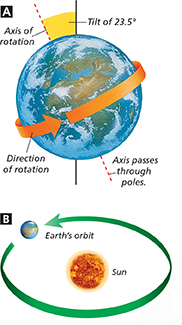24.2 The Sun and the Seasons
Reading Focus
Key Concepts
 What are two ways in which Earth moves?
What are two ways in which Earth moves? How is Earth's surface divided into zones based on latitude?
How is Earth's surface divided into zones based on latitude? What causes the seasons?
What causes the seasons?
Vocabulary
rotation
revolution
tropic zone
temperate zones
polar zones
solstice
equinox
Reading Strategy
Building Vocabulary Draw a table like the one below that includes all the vocabulary terms listed for the section. As you read, define each vocabulary term in your own words.
Vocabulary Term |
Definition |
Rotation |
a. |
Revolution |
b. |
Figure 7 Earth is constantly moving in two ways. A Earth rotates around its axis once a day. B Earth revolves around the sun once a year.
 d
dNo one can feel it, yet Earth is constantly moving in space.  Earth moves in two major ways: rotation and revolution. As shown in Figure 7A, Earth spins like a top around an imaginary line, or axis, that connects the north and south geographic poles. The poles are the two points at opposite ends of Earth where Earth's axis intersects the surface. The spinning of Earth on its axis is called rotation. Earth's rotation causes day and night. As Earth rotates from west to east, the sun appears to move from east to west across the sky. As Earth continues to spin toward the east, the sun sets in the west and night falls. It takes one day, or just under 24 hours, for Earth to complete one rotation.
Earth moves in two major ways: rotation and revolution. As shown in Figure 7A, Earth spins like a top around an imaginary line, or axis, that connects the north and south geographic poles. The poles are the two points at opposite ends of Earth where Earth's axis intersects the surface. The spinning of Earth on its axis is called rotation. Earth's rotation causes day and night. As Earth rotates from west to east, the sun appears to move from east to west across the sky. As Earth continues to spin toward the east, the sun sets in the west and night falls. It takes one day, or just under 24 hours, for Earth to complete one rotation.
As Earth rotates on its axis, it also travels around the sun, as shown in Figure 7B. Revolution is the movement of one body in space around another. It takes Earth one year, about days, to complete a full revolution around the sun. Earth revolves around the sun in a broad path, or orbit.
Earth's Latitude Zones
Different parts of Earth receive different amounts of sunlight depending on their latitude. Latitude measures distance in degrees north or south of the equator. For example, the equator is at 0° and the North Pole is at 90° north latitude. As you can see in Figure 8, regions near the equator receive more direct sunlight than the poles. As a result, Earth is generally warmer near the equator and colder toward the poles.





